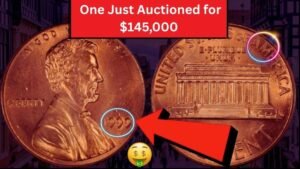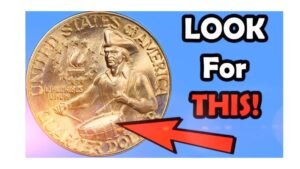In 2025, a regular-looking $1 bill from 2017 made headlines when it sold for an incredible $42,000 at auction. What made this ordinary bill so valuable? A rare feature called a “ladder serial number.” This exciting discovery has people across the country checking their wallets for similar treasures.
we’ll explain what makes a 2017 $1 bill valuable, how to spot one, and what to do if you find it. Let’s dive into the world of rare currency and uncover the secrets of this life-changing $1 bill!
Why Is a 2017 $1 Bill Worth So Much?
Certain $1 bills from 2017 are fetching high prices because of unique features that make them stand out to collectors. The bill that sold for $42,000 had a special serial number pattern known as a “ladder.” This rare trait, combined with the bill’s excellent condition, turned it into a collector’s dream. Here’s why these bills are so special:
- Unique Serial Numbers: A ladder serial number has digits in a perfect sequence, like 12345678 or 87654321. These patterns are extremely rare because the U.S. Bureau of Engraving and Printing produces billions of bills, and only a tiny fraction have this sequence.
- Pristine Condition: Bills in crisp, uncirculated condition (no folds, tears, or wear) are worth more to collectors.
- Collector Demand: The growing interest in rare currency has driven up prices for bills with unique features, making them highly sought-after.
This combination of rarity and condition can turn a simple $1 bill into a small fortune.
What Is a Ladder Serial Number?
A ladder serial number is a sequence of digits that go in perfect order, either ascending (12345678) or descending (87654321). Since U.S. dollar bills have eight-digit serial numbers (not counting prefix or suffix letters), only two perfect ladder combinations are possible. This rarity makes them incredibly valuable to collectors who specialize in “fancy serial numbers.”
How Rare Are Ladder Serial Numbers?
Ladder serial numbers are like finding a needle in a haystack. With billions of $1 bills printed each year, the odds of getting a perfect ladder are extremely low. Collectors are willing to pay top dollar—sometimes $25,000 to $60,000—for these bills, especially if they’re in mint condition.
How to Spot a Valuable 2017 $1 Bill
You might have a valuable $1 bill in your wallet right now! Here’s a step-by-step guide to check for a rare 2017 $1 bill:
Step 1: Check the Series Year
Look at the front of the bill for the series year, usually printed near the bottom. For this guide, focus on bills from the 2017 series. The bill that sold for $42,000 was a 2017 series note.
Step 3: Check the Condition
The bill’s condition matters a lot. A crisp, uncirculated bill with no folds, tears, or stains is worth more. If your bill looks worn or damaged, it may still have value, but it won’t fetch as much.
Step 4: Look for Other Rare Features
Besides ladder serial numbers, other features can increase a bill’s value:
- Star Notes: These have a star symbol (★) in the serial number, indicating a replacement note.
- Printing Errors: Look for mismatched numbers, double seals, or other printing mistakes.
- Low Serial Numbers: Numbers like 00000001 are highly collectible.
What to Do If You Find a Rare $1 Bill
If you think you’ve found a valuable 2017 $1 bill, follow these steps to protect it and maximize its value:
| Action | Description |
|---|---|
| Preserve the Bill | Place it in an acid-free plastic currency sleeve to prevent damage. |
| Photograph It | Take clear photos of both sides in good lighting for documentation. |
| Get It Authenticated | Contact a professional grading service like PMG or PCGS to verify authenticity. |
| Contact Experts | Reach out to auction houses like Heritage Auctions or Stack’s Bowers for advice. |
These steps ensure your bill stays in top condition and gets properly evaluated.
Why Collectors Love Rare $1 Bills
Currency collecting, also called numismatics, is a growing hobby. People are fascinated by the history and artistry of paper money. Rare $1 bills, especially those with unique serial numbers or errors, are like tiny pieces of history that tell a story. The 2017 $1 bill that sold for $42,000 sparked excitement because it was still in circulation, meaning anyone could find a similar treasure in their pocket change.
Features That Make a 2017 $1 Bill Valuable
| Feature | Description | Potential Value |
|---|---|---|
| Ladder Serial Number | Digits in perfect sequence (e.g., 12345678) | $25,000–$60,000 |
| Star Note | Serial number with a star symbol (★) | $20–$500 |
| Printing Error | Mismatched numbers, double seals, etc. | $500–$10,000+ |
| Low Serial Number | Numbers like 00000001 | $1,000–$50,000+ |
| Uncirculated Condition | Crisp, no folds or tears | Higher value than circulated |
Conclusion
The story of a 2017 $1 bill selling for $42,000 is a reminder that treasures can hide in plain sight. By checking your cash for ladder serial numbers, star notes, or printing errors, you could uncover a valuable gem. Take a moment to inspect the bills in your wallet, purse, or old drawers—you might be holding a small fortune! If you find a rare bill, protect it carefully and get it authenticated to maximize its value. Start your treasure hunt today, and who knows? You could be the next person to make headlines with a life-changing discovery.
FAQs About Rare 2017 $1 Bills
What makes a 2017 $1 bill valuable?
A 2017 $1 bill is valuable if it has a rare feature like a ladder serial number (e.g., 12345678), a printing error, or a star note. The bill’s condition also plays a big role.
How do I know if my $1 bill has a ladder serial number?
Check the serial number on the front of the bill. A ladder serial number has digits in perfect order, like 12345678 or 87654321.
Where can I sell a rare $1 bill?
You can sell rare bills through auction houses like Heritage Auctions, online marketplaces like eBay, or currency dealers. Always get the bill authenticated first.
Are all 2017 $1 bills valuable?
No, most 2017 $1 bills are worth only $1 unless they have rare features like ladder serial numbers, star notes, or printing errors.
How can I protect my rare $1 bill?
Store it in an acid-free plastic sleeve, avoid folding or cleaning it, and have it graded by a professional service like PMG or PCGS.




